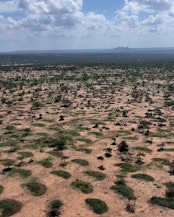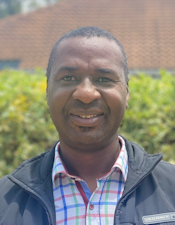Multi-purpose corridors and ecosystem restoration

Multi-purpose corridors and ecosystem restoration
- Our Objective
This project supports the restoration and reconnection of critical ecosystems in northern Kenya through collaborative land-use planning and community-led conservation efforts.
- Figures
The project was launched on March 17, 2022 and is currently in progress.
Summary
In northern Kenya, communities, conservation groups, and local governments are working together to restore rangelands and keep them connected. As farmland expands and grazing pressure grows, it is harder for both livestock and wildlife to move between seasonal pastures and water sources.
This project supports a network of multi-purpose corridors that maintain access for herds while protecting wildlife routes. Alongside plans to formally protect one corridor nationally and five locally, communities are building thousands of semi-circular bunds to bring degraded soils back to life. Local leaders and technical partners are also testing virtual fences to help reduce conflict between people and wildlife, while research around Mount Kenya is showing how forest health supports downstream water flows.
By bringing together practical restoration, local knowledge, and shared planning, communities are creating corridors that support healthier ecosystems, stronger livelihoods, and better coexistence for the future.
Project Connections
- Part of the solutionscape
Enabling the co-existence of pastoralism and wildlife in semi-arid rangelands in an insecure climate
Timeline
How the Kachelitwa Community is leading rangeland restoration in Kenya's Baringo County
Project Update October 16, 2025
However, in early 2024, new partnerships brought renewed energy to Kachelitwa . Thanks to engagement with the neighboring Mukutan Conservancy, the Kachelitwa community—long uncertain about their options—realized that solutions for some of their most pressing problems were within reach through joint efforts. With support from Mukutan Conservancy, the Wyss Academy for Nature, Green Earth Warriors, and Just Dig It, experts joined the community to assess the damage in the most affected sites and design practical and cost-effective solutions. A 10-acre demonstration plot was identified as the testing ground for restoration methods before scaling up across the wider landscape.
Monitoring restored landscape
Project Update October 17, 2024
[NANYUKI, Kenya] It is said that variety is the spice of life, and this couldn't be more true than in nature – with its abundance of flora and fauna, and intricate networks of intra- and inter-dependencies to support various life forms. As often happens in our own lives, the “spice” requires periodic evaluation; are things working as they should (health), or is some tweaking necessary (change)? Similarly, biodiversity assessment is used to evaluate and determine the status of life in a defined area that may contain one or more types of ecosystems or habitats. The semi-arid landscape of Laikipia, Kenya, looks vastly different in dry versus wet seasons, prompting comparative assessment to establish conservation and restoration needs. For this reason, the Wyss Academy for Nature commissioned dry and wet season (July/August, 2023, and April, 2024, respectively) biodiversity and socioecological assessments of local livelihoods in Naibunga Community Conservancy, conducted in collaboration with expert teams from the University of Nairobi, the National Museums of Kenya, Technical University of Kenya, and the Directorate of Resource Surveys and Remote Sensing. This biodiversity assessment was the first of its kind in the Naibunga Community Conservancy and examined a wide range of taxonomic groups including birds, mammals, reptiles, amphibians, invertebrates, and plants in a restored landscape. Their presence, or absence, is used as indicators of ecosystem health. Findings from the assessments have been consolidated in a recent report, that will be an important source of information for monitoring the impact of semi-circular bunds as landscape restoration mechanisms and for development of income generating activities. Further, the comparative season-focused data is a positive contribution for designing and identifying indicator species for long term future monitoring of changes in species composition. Concerning inclusivity in biodiversity conservation, Professor Margaret Owuor, an accomplished conservation ecologist and lead of the Integrative Biodiversity Conservation Science research team at the Wyss Academy for Nature, opines,
The Stuff of Dreams
Project Update May 6, 2024
*Some parts of this text are based on a post by the Isiolo County Government *📍NANYUKI, KenyaFor most of us, some of the fondest childhood memories featured a hero of some kind; someone to look up to, to model our entire character around, and to grow up to be. To embody this hero, we learned everything there was to know about them: their values, their processes, and their likes and dislikes. In the same way, developing plans and implementing processes looks to existing—and successful—models such as Konza Technopolis for inspiration. Oldonyiro town in Isiolo county, Kenya, contends with ever-growing human settlements that threaten elephant corridors, in turn heightening human-wildlife conflict. The Isiolo County Government, in partnership with the Wyss Academy for Nature, Save the Elephants (STE), and Northern Rangelands Trust (NRT), is prioritizing smart urban planning for Oldonyiro town to secure these corridors, and ensure elephants in northern Kenya can move freely in their natural habitat. Antony Wandera, Projects Manager at the Wyss Academy Hub East Africa, said of the County’s initiative, “Oldonyiro town is a critical corridor connecting Laikipia to Isiolo and Samburu and is currently under threat of unplanned development from changes in land tenure. We welcome this effort because there is certainly a need for planning for wildlife connectivity alongside urban development, and to retain historical elephant routes in towns like Oldonyiro.” In March, 2024, the Department of Lands and Physical Planning of the Isiolo County Government hosted a site visit to Oldonyiro town to familiarize themselves with the elephant movements in and around Oldonyiro town, and threats brought by settlements to these routes. The objective of the visit was to gather insights towards co-designing a nature-focused town plan, as part of people-nature smart landscape and land-use planning for development. For its similarities to Oldonyiro as far as having a wildlife corridor, a first visit to Konza Technopolis followed, where the county planning team witnessed a successful planning and implementation model in action. A few weeks later, an extensive town planning concept for Oldonyiro—including a work plan and budget—was finalized by the key government departments and partners, and including the National Land Commission, and the National Survey department.
Mapping of critical natural assets, Kenya
Project Update December 27, 2023
In a collaborative effort with our local partners, CETRAD , the National Land Commission (NLC) and the Northern Rangelands Trust (NRT), the Wyss Academy has successfully mapped an area larger than 54,000 km2 in Kenya. The region studied is larger than the size of Switzerland and encompasses the counties of Laikipia, Isiolo and Samburu. As a result of this initiative, more than 3,500 critical natural assets were identified and documented, including springs, wetlands, salt licks, and dry-season grazing areas. All information is now available for consultation and use by local decision-makers. The goal is to help ensure that these natural assets are formally included in a natural asset register and protected by law. In addition to the natural assets, the mapping has also integrated other important information, such as citizen knowledge and various levels of governance, including grassroots and county-level governments. These were identified during the mapping process, and an efficient methodological approach was developed to incorporate them into the assessment. Learnings from this process will now be shared with other counties in Kenya and have the potential to be scaled to other dryland counties, helping to further protect critical natural resources.
Semi-circular bunds project: Vegetation is growing and elephants are visiting!
Project Update December 19, 2023
The Wyss Academy for Nature’s teams are thrilled to share exciting news about our ongoing efforts in Laikipia County, Kenya, where we partner with the Naibunga Community Conservancy. The latest satellite imagery, captured for monitoring the semi-circular bunds, has revealed remarkable progress and development in the growth of vegetation. The contrast from March 2023, when the initial bunds were dug into the ground, to the current state recorded in December 2023, is visible. Over time, the soil has become greener, and we were able to deepen ties and collaboration with the local community and our partners. The images are also surprising because they show elephants in the area. A herd has been captured visiting the bunds, adding another layer of significance to our work. Witnessing this positive impact reinforces our commitment to fostering a better relationship between people and nature.
Scaling from 5000 to 136,455 bunds: Making Northern Kenya greener
Project Update September 20, 2023
We are seeing promising results of our approach in Northern Kenya: The semi-arid landscape there is turning a little greener. We are combining a known method to protect precious water and soil, semi-circular bunds, with traditional systems and our solutionscapes approach to assure long-term success.This youth-led initiative by the Green Earth Warriors, with the Wyss Academy as catalyst and technical expertise by Justdiggit, has expanded to involve around 500 households and three local women’s groups- the Twiga Mamas, the Chui Mamas and the Naitutum Women’s group – and has scaled up from 5000 to 136,455 on 796 hac projected bunds within only a few months. Through our integrated monitoring and evaluation system, we can provide data on this approach for like-minded partners. Hopefully, other regions may benefit from this solution.
Team
- Project contactProject contact
Antony Wandera
Project Manager
Other Projects in this Solutionscape
Solutions for sustainable water resources and biodiversity conservation
Solutions for sustainable water resources and biodiversity conservationMonitoring multi-dimensional impacts of payment for ecosystem service projects
Monitoring multi-dimensional impacts of payment for ecosystem service projectsHealthy and functional semi-arid landscapes—Co-design knowledge and engagement
Healthy and functional semi-arid landscapes—Co-design knowledge and engagement










